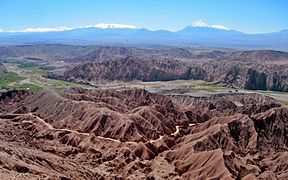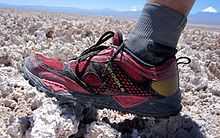4 Deserts
| 4 Desserts Race Series and Roving Race | |
|---|---|
 The company logo of 4 Deserts Race Series and Roving Race. | |
| Genre | Rough country endurance footrace |
| Begins | March |
| Ends | December |
| Frequency | Annual |
| Location(s) | Chile, China, Egypt, Antarctica |
| Years active | 13 |
| Attendance | Max 200 competitors |
| Website | |
| www.4deserts.com | |
The 4 Deserts Race Series is an annual series of four 250 km (155 miles) races across desert conditions in various parts of the world. It was recognised as the world's leading endurance footrace series as named by TIME magazine in 2009 and 2010,[1] and by others as the "Ultimate test of human endurance".[2] The series was founded by American Mary K Gadams who founded RacingThePlanet in 2002.
The inaugural race, the Gobi March, was run in China in 2003. Over the next three years a new race was added to series each season. In 2004 it was the Atacama Crossing (Chile) and in 2005 it was the Sahara Race (Egypt), until in 2006 all 4 Deserts events were raced in one year with The Last Desert Antarctica being the ultimate event in the series.
Competitors can enter any of the individual multiday races within the 4 Deserts series, but if they wish to take part in The Last Desert (Antarctica) then they must complete a minimum of two of the other races and receive an invitation to participate.
To date, forty five races have been staged over twelve years and more than 7000 individuals from 100 countries have competed in the 4 Deserts Race Series or Roving Races. Most participants return to complete a second event, and many have now completed the whole race series and many Roving Races.
In 2013, a documentary film about 4 Deserts was released. Desert Runners, directed by Jennifer Steinman, follows four participants as they attempt to complete the series in 2010. The Desert Runners documentary was awarded many film awards.
4 Deserts Race Series and Roving Race
The events that combine to make the 4 Deserts Race Series are:
Atacama Crossing (Chile)


The Atacama Crossing takes place in March, crossing Chile’s brutal Atacama Desert, the driest place on Earth.[3] The Atacama has a unique landscape of salt lakes, volcanoes, lava flows and sand dunes.
The Atacama Crossing is gruelling not only because of the terrain which is rarely flat underfoot, and harsh climate, but also because of the altitude that averages 2500 m (8000 ft) during the race.
The Atacama Crossing always uses the town of San Pedro de Atacama as its host town, and in 2012 the race began at its highest point over 3,000m in the Arcoiris Valley.
Gobi March (China)
The race takes place in various locations around the Chinese area of the Gobi Desert, and is usually held in June. in 2012 it took place around the region of Kashgar within sight of the Pamir Mountains to the west visiting such landmarks as Heaven's Gate. 2013 will be the 10th edition of the Gobi March and a brand new course is being planned.
The Gobi March's challenges include the changes in temperature from the cool highlands to the oppressive heat in sand dunes, the complete lack of shade, potential sandstorms and variety of terrain – soft sand-dunes, rocky tracks, steep hills, ridges and riverbeds.
A Shanghai-based competitor died of heatstroke after competing in the 2010 Gobi March. His brother (who was not at the race) claimed Racing the Planet was "reckless" to set such a course for non-professional athletes, and ill-prepared.[4]
Sahara Race (Egypt)
The Sahara segment takes place, usually in October, in the hottest desert in the world. Competitors have to contend with a variety of terrains, both rock and sand, but will face endless miles of sand dunes up to 122 metres (400 feet) high. Daytime temperatures reach 50 °C.
In 2012 the race will take place for the third time in the Western Desert around the region around Al Fayuum, Wadi El-Rayan Protected Area and The Valley of the Whales or Wadi Al-Hitan, a UNESCO World Heritage Site.
Due to political unrest the 2014 edition of the race was moved to Jordan where it crossed four deserts; Wadi Rum, Kharaza, Humaima and Wadi Araba before finishing in the ancient city of Petra
The Last Desert (Antarctica)
The race uses a polar expedition ship as its base, traveling to the different course locations on the Antarctic Peninsula and offshore islands based on the prevailing sea and weather conditions, with competitors transferred from ship to shore by zodiacs. Since 2010, this segment has been held biennially to minimise its environmental impact, and usually takes place around the end of November.
The unique challenges of The Last Desert (Antarctica) include having to cope with the severity of the weather conditions that can include gale force blizzards and temperatures down to −20 °C (4 °F). Competitors also have to deal with the unpredictability of daily stage lengths and start-times, as the prevailing environmental conditions dictate where and when stages might begin.
Fifteen individuals from around the world completed the inaugural event in 2006 becoming the first in the world to complete a 250 km footrace on the Antarctic continent. The Last Desert 2010 took place in November of that year in King George Island, Deception Island, and Dorian Bay. The Last Desert 2010 was featured 3 times on IMG's Transworld Sport.
Event format
The 250 km (155 mile) races take place over seven days and six stages. A campsite is raised each night for competitors where they are provided with a place in a tent to sleep, access to hot water, a campfire, medical assistance and the CyberTent where they can view and send messages to family and friends and update their race blog.
Competitors race from campsite to campsite each day following marker flags that have been planted the preceding day. They must pass through a series of checkpoints where they collect drinking water and can seek medical treatment.
Other than the access to the services described competitors must race completely self-supported, carrying all their food, supplies and equipment for the week. Each competitor must carry a selection of mandatory items at all times to help ensure their safety out on course.
Competitors must start each stage at the appointed time and on certain stages cut-off times are set which racers must meet in order to remain active in the event.
The results of the race are based on the cumulative time taken for the competitor to complete all the stages, and a competitor must successfully pass through every checkpoint in order to collect a finisher's medal.
Should a competitor withdraw from a particular stage, they may not continue in the race.
Charitable causes
About 50% of competitors choose to support causes when racing at the 4 Deserts.
Because of the remote locations of many of the races RacingThePlanet choose to support a specific charity at almost every event, that provides support to the local community in which the event takes place. The company has a long running partnership with Operation Smile,[5] and has raised over US$500,000 for the charity for projects in Vietnam, China and Egypt, often funding missions and surgeries in the local communities through which competitors race.[6][7]
The company has donated books and sports equipment to schools in Xinjiang province where the Gobi March is held through the Esquel Y. L. Yang Education Fund who they have also supported for a number of years.[8]
In 2008, the Gobi March took place just one month after the devastating earthquake in Sichuan Province on 12 May, so that year RacingThePlanet put together a special auction whereby friends and families of competitors could bid to buy a hot shower for three competitors at the end of the 90 km Stage 5 of the event. An unheard of and never-to-be-repeated luxury. The auction raised almost US$30,000 for the Red Cross disaster fund.[9]
Again in 2010 another earthquake affected a country that plays host to a 4 Deserts race. The Chilean earthquake of 27 February occurred just one week before the start of the Atacama Crossing. RacingThePlanet and the community of competitors and friends raised US$15,000 for Habitat for Humanity in the weeks to follow.[10]
4 Deserts champions
At the end of every edition of The Last Desert (Antarctica) the 4 Deserts Champion is crowned. From 2010 both a male and female champion was recognized in this way, and female champions from previous years have now been crowned retrosopectively.
The champion is determined by adding up the finishing rank of every competitor over the four races of the series to see who has the lowest aggregate score.
In 2012, Anne-Marie Flammersfeld of Germany emerged as the first woman to ever win all four events in the 4 Deserts series—and not only that, she did it all in one year. “My objective was the 4 Deserts Grand Slam,” explains the 34-year old fitness trainer and sports scientist who is based in Switzerland. “I started training mid-2011. The Atacama Crossing was my first ultra ever and it was all about the first experience... It was really only after the Sahara Race that I knew I could do this.”
The Spanish racer, Vicente Juan Garcia Beneito came to Antarctica having already won each of the 4 Deserts races in 2012, including the Atacama Crossing (Chile), the Gobi March (China) and Sahara Race (Egypt). By winning The Last Desert (Antarctica), he joins Ryan Sandes as the only other person to have been champion of every race in the 4 Deserts series—but Beneito has taken it up a notch by winning them all in one calendar year for the first time.
In 2010 Ryan Sandes of South Africa recorded the lowest and unbeatable aggregate score of 4 points, as he had won each of the 4 Deserts races he had entered.[11]
Current 4 Deserts champions (crowned in 2012)
Male: GARCIA BENEITO, Vicente Juan
Female: FLAMMERSFELD, Anne-Marie
Current 4 Deserts champions (crowned in 2010)
Male: Ryan Sandes, South Africa[12]
Female: Mirjana Pellizzer, Croatia
Previous 4 Deserts champions
2008
Male: Dean Karnazes, USA
Female: Laura Corti, Italy
2007
Male: Francesco Galanzino, Italy
2006
Male: Kevin Lin Yichieh, Taiwan
Female: Lisanne Dorian, United States
4 Deserts Club
The 4 Deserts Club recognises those competitors who have completed all four races of the series.
There are currently just 87 individuals in the club.
4 Deserts Grand Slam
The 4 Deserts Grand Slam has been so named by competitors attempting to complete all the 4 Deserts events in one calendar year.
The first Grand Slam was completed in 2008, when five competitors set out to complete, with two ultimately successful: famed endurance athlete Dean Karnazes of the United States and Paul Liebenberg of South Africa.[13] In 2010, fourteen competitors attempted to complete the feat and nine were successful, including the first three women.
The 4 Deserts Grand Slammers so far are:
2008
Dean Karnazes, USA
Paul Liebenberg, South Africa
2010
Paul Acheson, UK
Samantha Gash, Australia
Peter Jong, Australia
Stan Lee, Canada
Terumasa Mori, Japan
David O'Brien, Ireland
Linda Quirk, USA
Lucy Rivers-Bulkeley, UK[14]
Philip Tye, UK
2012
Alper Dalkılıç, Turkey
Christian Sebastián Colque, Argentina
Individual race results
Times are shown in hours:minutes:seconds
Atacama Crossing (Chile)
| Year | Men's Winner | Women's Winner |
|---|---|---|
| 2013 | Daniel Rowland (28) Zimbabwe, 26:17:51 | Rebecca Pattinson (40) UK, 35:38:09 |
| 2012 | Vicente Juan Garcia Beneito (35) Spain, 23:46:51 | Anne-Marie Flammersfeld (33) Germany, 29:49:53 |
| 2011 | Anders Jensen (29) Denmark, 30:49:05 | Nahila Hernandez San Juan (36) Mexico, 38:16:25 |
| 2010 | Ryan Sandes (27) South Africa, 23:58:39 | Joanna Zakrzewski (33) UK, 33:37:30 |
| 2009 | Mehmet Danis (34) Canada, 31:56:27 | Fleur Grose (34) Australia, 37:31:54 |
| 2008 | Dean Karnazes (45) USA, 31:49:44 | Mimi Anderson (45) US, 43:15:16 |
| 2007 | Robert Jarvis (40) New Zealand, 35:12:09 | Emma Dawber (41) UK, 47:09:35 |
| 2006 | Mark Tamminga (47) Canada, 32:16:06 | Sandra McCallum (43) Canada, 44:14:38 |
| 2004 | Lin Yichieh (Kevin) (27) Taiwan, 27:36:29 | Lisanne Dorion (38) USA, 41:04:37 |
Gobi March (China)
| Year | Men's Winner | Women's Winner |
|---|---|---|
| 2012 | Vicente Juan Garcia Beneito (36) Spain, 23:12:33 | Anne-Marie Flammersfeld (31) Germany, 27:53:21 |
| 2011 | Damon Goerke (37) Australia, 26:28:39 | Jennifer Madz (31) Australia, 34:41:19 |
| 2010 | Dan Parr (33) UK, 24:53:36 | Denvy Lo Singapore, 33:25:49 |
| 2009 | Eric LaHaie (28) USA, 26:43:50 | Diana Hogan-Murphy (31) Ireland, 36:26:25 |
| 2008 | Ryan Sandes (25) South Africa, 24:38:20 | Lia Farley (37) USA, 32:09:35 |
| 2007 | Mark Tamminga (49) Canada, 29:06:55 | Nina Breith (45) Germany, 33:44:15 |
| 2006 | Mark Tamminga (47) Canada, 32:16:06 | Sandra McCallum (43) Canada, 36:32:27 |
| 2004 | Lin Yichieh (Kevin) (27), 27:36:29 | Lisanne Dorion (38) USA, 41:04:37 |
| 2003 | Charles Engle Jr (33) USA, 30:58:22 | Ms Aletengtya, China, 48:25:37 |
Sahara Race (Egypt)
| Year | Men's Winner | Women's Winner |
|---|---|---|
| 2012 | Vicente Juan Garcia Beneito (36) Spain, 25:36:12[15] | Anne-Marie Flammersfeld (33) Germany, 30:48:33[15] |
| 2011 | Dan Parr (34) UK, 25:13:22 | Sophie Collett (27) UK, 38:02:26 |
| 2010 | Anders Jensen (28) Denmark, 26:56:28 | Katia Figini (34) Italy, 32:03:29 |
| 2009 | Paolo Barghini (48) Italy, 28:14:38 | Erica Terblanche (37) South Africa, 38:15:02 |
| 2008 | Ryan Sandes (25) South Africa, 27:09:17 | Nina Breith (45) Germany, 32:50:37 |
| 2007 | Andrew Murray (26) Scotland, 30:11:44 | Sandy McCallum (44) Canada, 39:55:24 |
| 2006 | Jimmi Olsen (28) Denmark, 26:55:04 | Claire Price (37) UK, 32:58:00 |
| 2005 | Ray Zahab (35) Canada, 26:24:45 | Theresa Schneider (40) USA, 32:18:54 |
Last Desert (Antarctica)
When the full 250 km distance cannot be completed due to sea and weather conditions, the results are calculated in a different way for The Last Desert (Antarctica). Rank is based on total distance covered.
| Year | Men's Winner | Women's Winner |
|---|---|---|
| 2012 | Vicente Juan Garcia Beneito (36) Spain, 200.35 km | Anne-Marie Flammersfeld (34) Germany, 186.95 km |
| 2010 | Ryan Sandes (28) South Africa, 230.5 km | Diana Hogan-Murphy (33) Ireland, 165 km |
| 2008 | Paul Liebenberg (33) South Africa, 76.98 km | Louise Cooper (54) USA, 59.68 km |
| 2007 | Joseph Holland (42) USA, 133.6 km | |
| 2006 | Scott Smith (49) USA, 29:06:37 | Lisanne Dorian (40) USA, 35:35:40 |
References
- ↑ "Top 10 Endurance Competitions". TIME. Retrieved 2010-06-14.
- ↑ "Off Limits" (PDF). Men's Health.
- ↑ Vesilind, Priit J. (August 2003). "The Driest Place on Earth". National Geographic Magazine. Retrieved 3 January 2014. (Excerpt)
- ↑ O'Brien, Amanda (9 September 2011). "Extreme race firm 'reckless in past'". The Australian.
- ↑ 4 Deserts. 4 Deserts. Retrieved on 2011-10-09.
- ↑ Sahara Race (Egypt) 2011 Official Website. 4deserts.com (2011-10-02). Retrieved on 2011-10-09.
- ↑ 4 Deserts. 4 Deserts. Retrieved on 2011-10-09.
- ↑ Gobi March (China) 2011 Official Website. 4deserts.com (2011-10-02). Retrieved on 2011-10-09.
- ↑ 4 Deserts. 4 Deserts. Retrieved on 2011-10-09.
- ↑ 4 Deserts. 4 Deserts. Retrieved on 2011-10-09.
- ↑ iafrica.com | sport | video | Sandes makes history. Sport.iafrica.com. Retrieved on 2011-10-09.
- ↑ "The Last Desert" (PDF). Sports Illustrated.
- ↑ Hamlyn, Alexandra (31 July 2008). "The Long March". Time.
- ↑ "Gloucestershire fund-raiser wins award for her efforts". BBC. 11 February 2011.
- ↑ 15.0 15.1 "Vicente Juan Garcia Beneito and Anne-Marie Flammersfeld Gain Extraordinary Victories at the Sahara Race 2012" (Press release). RacingThePlanet. 3 Nov 2012. Retrieved 2012-12-05.
External links
2012 Grand Slam James Gaston, Jr. USA Tara Gaston USA